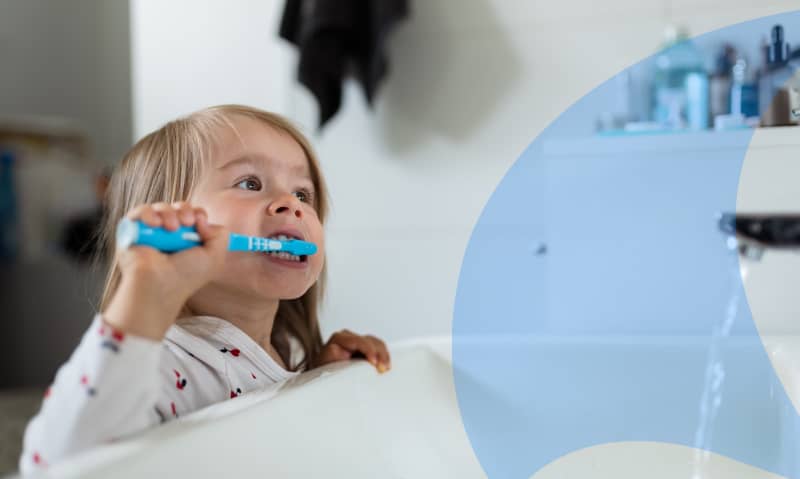Help! My Toddler Refuses to Let Me Brush Their Teeth. What Should I Do?

5 Tips To Make Toothbrushing With Your Toddler Easier
As a parent, you may be doing everything right when it comes to protecting your child’s oral health—taking your child to routine appointments, providing them with a healthy diet, and keeping sugary and starchy snacks to a minimum.
But if your toddler is refusing to let you brush their teeth, it can be both frustrating and concerning, as brushing is one of the most important aspects of oral health. These tips can help ensure you’re taking the right approach.
1. Get your child engaged in toothbrushing.
Fun is a top priority for toddlers. While it’s important to teach your toddler some important things must be done even when they aren’t fun, there’s no need to make toddler toothbrushing more difficult than it has to be.
Involving your child in the toothbrushing process can help get them on board. While they are too young to handle brushing on their own, you can still take steps to make it an activity they activelytake part in. For example, you can involve them in choosing the specific toothbrush and toothpaste they use.
Pretend toothbrushing with a stuffed animal, doll, or other toys is also an excellent option. Simply have your child “brush” the toy’s teeth with a dry brush, imitating how you brush your child’s teeth.
There are plenty of toys specifically geared toward promoting good oral hygiene. For toddlers, Brushy Brush Elmo is a particular favorite. Your child will enjoy brushing their Sesame Street friend’s teeth, and the toy even sings a brushing song to serve as a timer.
2. Make a game of toddler toothbrushing.
Various toys can get your child excited about brushing and help teach them how to brush, but you can also make brushing itself into a game. Your child may be less fussy about brushing if it’s more like playtime.
Singing a song or reciting a rhyme about brushing can be a great way to incorporate this idea. Tell a story about each tooth as you brush, which helps create an engaging narrative and stresses the importance of reaching every tooth.
Small rewards after brushing can also be effective. This could be as simple as a fun activity like blowing bubbles or coloring after brushing. Tracking progress with a sticker chart or by adding marbles to a jar can reward your child and instill a sense of progress.
3. Build strong oral hygiene habits.
As a parent, the best thing you can do for your child’s oral hygiene is to help them develop strong habits. Your child is less likely to be upset about brushing when it’s a regular habit that happens daily, without fail.
Stick to as close to the same time each day as much as possible, typically once in the morning and once in the evening. You can also make things easier by holding your child during brushing, with the best position being with their head in your lap.
Keep in mind that your child observes your habits as well, so make sure that they see you brush, too. Letting them “help” you from time to time can make them feel better about toddler toothbrushing.
4. Make sure you’re using the correct technique.
Your child might be upset about brushing due to improper technique causing discomfort. You want to make sure that you aren’t brushing against the grain of the labial frenulum. This is the thin piece of tissue that attaches the upper lip to the upper gum, and brushing horizontally against it can cause serious discomfort.
You can also make flossing easier with waxed floss. This is softer than unwaxed floss, so your child won’t experience discomfort during flossing.
5. Find products that support toddler toothbrushing.
Choosing the right toothbrush and toothpaste is also key to ensuring the comfort of your child during brushing. The best toothbrush for kids is generally softer. Look for ADA-approved toothbrushes specifically designated for toddlers. The same goes for toothpaste, which comes in a variety of mild flavors.
Children with sensory sensitivities may require special care when selecting products. An extra-soft brush, such as the Radius Totz, is a good place to start, as it is extremely gentle. Brushing using gauze is another potential option. You can always ask your pediatric dentist for advice in handling your child’s unique needs.
Start your child off with a solid foundation for oral health.
Making sure your child develops good oral hygiene and gets the care they need during their development can build a foundation for lifelong oral health.
Spinnaker Pediatric Dentistry is here to provide your child with everything they need for a happy and healthy smile. We’re your pediatric dentist in Salem, Oregon, for preventive care and other important treatments during your child’s development.
With a focus on using the most advanced technology for pediatric dental care—backed by extensive training—we deliver exceptional results and a comfortable experience for your child. Schedule your child’s next appointment today.